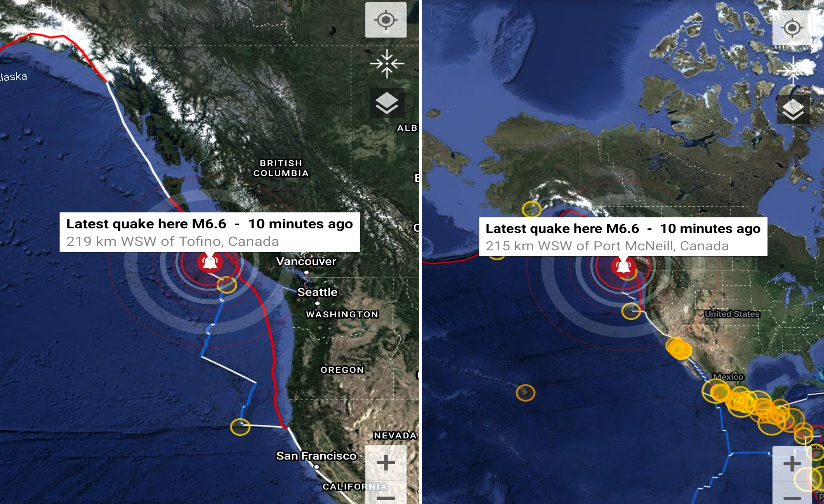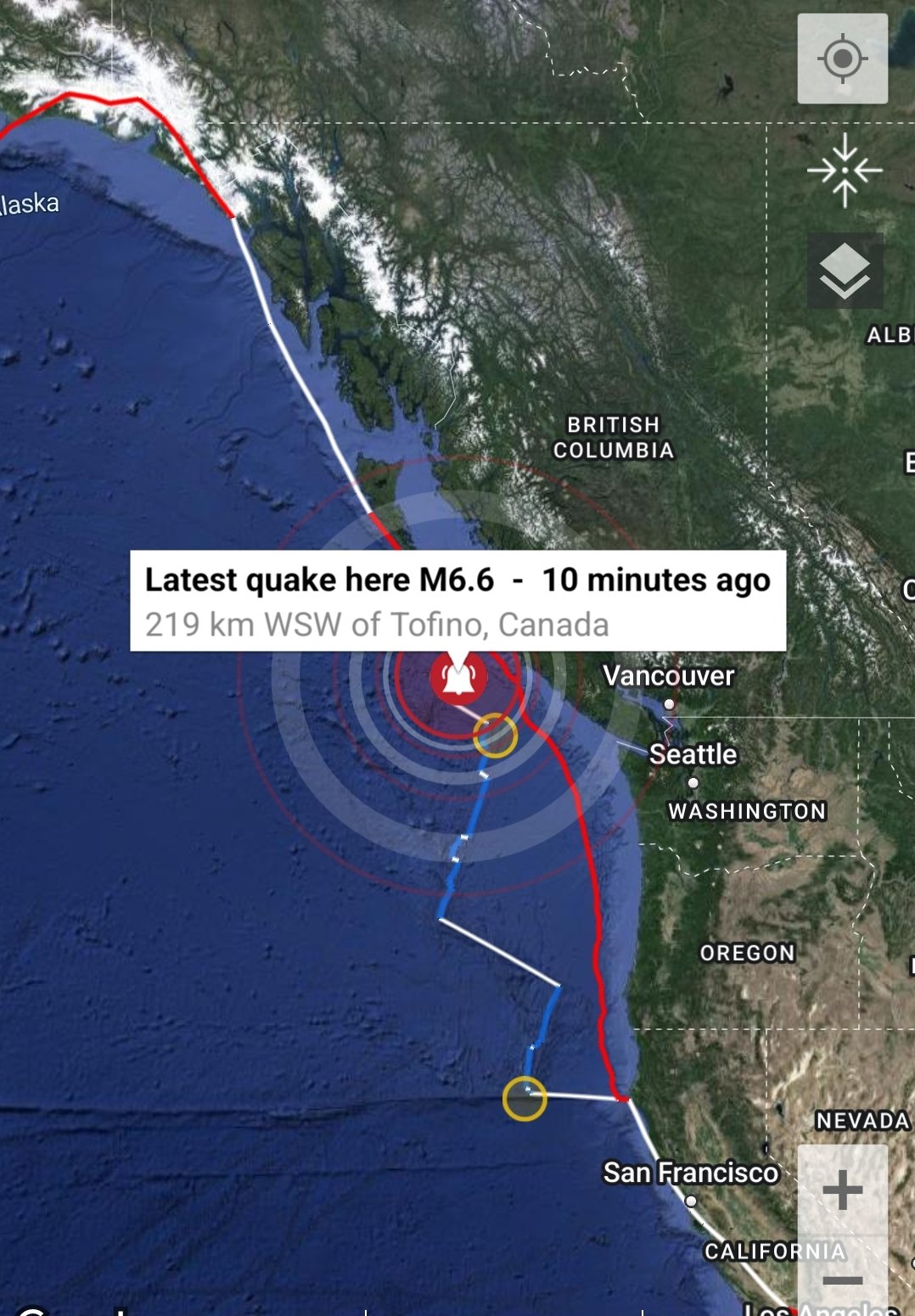By Medeea GreereJuly 11, 20241 Comment7 Mins Read
FacebookTwitterTelegramWhatsApp

SHARE
Breaking News: Major Earthquake Strikes Near Oregon! A Wake-Up Call for the Cascadia Region – Prepare for the Big One!
Ready to uncover the truth? Sick of the lies? Join our Telegram Channel now. It’s time for the real story! My gratitude to all my readers!
In a terrifying display of nature’s raw power, a massive earthquake measuring 7.0 on the Richter scale, later downgraded to 6.6, has rocked the coastal waters off Oregon and Vancouver Island. This seismic event serves as a chilling reminder of the catastrophic potential lurking beneath the Pacific Northwest – the dreaded “Big One” from the Cascadia Subduction Zone.
A Tremor Felt Across the Pacific Northwest
Early this morning, residents of the Pacific Northwest were jolted awake by a significant earthquake that struck just off the coast of Oregon. The seismic waves reverberated through the region, leaving a trail of fear and uncertainty in their wake. Originally recorded at a magnitude of 7.0, the quake was soon downgraded to 6.6 by seismologists, but the impact was no less profound.


The Cascadia Subduction Zone: A Looming Threat
This recent earthquake, though significant, is merely a precursor to what geologists fear could be the most devastating seismic event in North America’s history. The Cascadia Subduction Zone, a 700-mile fault line stretching from Northern California to British Columbia, is capable of producing mega-quakes with magnitudes of 9.0 or higher. Such an event would unleash unimaginable destruction, crippling infrastructure and potentially claiming thousands of lives.
The Science Behind the Quake. Seismologists have long warned about the dangers posed by the Cascadia Subduction Zone. This area is where the Juan de Fuca Plate is slowly being forced beneath the North American Plate, a process known as subduction. Over centuries, stress builds up until it is released in a massive earthquake. The last major quake in this region occurred in 1700, and scientists believe we are overdue for another.
Preparing for the Inevitable. While today’s quake may not have been the catastrophic event many fear, it is a stark reminder of the importance of preparedness. Experts urge residents to have a plan in place – from securing heavy furniture to having emergency supplies ready. Schools, businesses, and governments must also prioritize earthquake preparedness and response plans.

What You Can Do
- Create an Emergency Plan: Ensure every family member knows what to do in case of an earthquake. Designate meeting spots and establish communication methods.
- Build an Emergency Kit: Stock up on essential supplies like water, non-perishable food, medications, and first-aid materials.
- Secure Your Home: Anchor heavy furniture, secure water heaters, and know how to shut off utilities.
- Stay Informed: Keep up-to-date with local news and weather reports. Sign up for emergency alerts.
Beyond the immediate physical dangers, the potential “Big One” could have significant political and social implications. The Pacific Northwest, often seen as a stronghold of liberal values, could see its infrastructure and governance severely tested. Some might argue that such a natural disaster could prompt a shift in political dynamics, potentially even “cleansing” the region of its current ideological leanings. While such statements are controversial, they underscore the deep social and political tensions that could be exacerbated by a major earthquake.
The Need for Resilient Infrastructure. Investing in resilient infrastructure is not just a matter of public safety; it is also a political necessity. Strengthening buildings, bridges, and roads can mitigate the damage from an earthquake, but it also requires substantial political will and financial investment. This is where local, state, and federal governments must collaborate, putting aside partisan differences to protect the lives and livelihoods of millions.
RELATED:
- HAARP: The Shadowy Force Behind Earthquake Weapons – The Big One: California’s Looming Catastrophe
- Breaking News: California “Megaquake” Coming Soon – Are We Ready for the Catastrophic Impact?
- Playing God: HAARP, Chemtrails, and Atmospheric Manipulation – Unleashing Earthquakes, Tsunamis, Volcanoes, and Extreme Weather
An earthquake of this magnitude would have a devastating economic impact on the region. The destruction of infrastructure, homes, and businesses would lead to billions of dollars in damages. The recovery process would be long and arduous, requiring significant federal assistance and international aid.
Homeowners and businesses should review their insurance policies to ensure they are adequately covered for earthquake damage. The real estate market could also see significant fluctuations, with properties in earthquake-prone areas potentially losing value.
The environmental impact of a major earthquake cannot be understated. Coastal areas could experience severe changes, including landslides, tsunamis, and soil liquefaction. The natural beauty of the Pacific Northwest, known for its lush forests and stunning coastlines, could be forever altered.
Efforts must be made to protect natural habitats and wildlife from the destructive forces of an earthquake. Conservation groups and government agencies need to develop strategies to minimize environmental damage and ensure the survival of endangered species.
⇒ Family Bunker Plans – The Ultimate Solution Is A Survival Bunker

The Pacific Northwest has a long history of seismic activity. Indigenous peoples have oral traditions that speak of great earthquakes and tsunamis that devastated their communities centuries ago. Understanding this historical context can provide valuable insights into preparing for future events.
By studying past earthquakes, scientists and emergency planners can develop more effective strategies for mitigating damage and saving lives. Historical records and geological evidence are crucial in predicting the potential impacts of future quakes.
Technological Advances in Earthquake Detection
Advances in technology have significantly improved our ability to detect and respond to earthquakes. Early warning systems can provide crucial seconds of notice, allowing people to take cover and utilities to shut down automatically.
Continued investment in earthquake detection and response technology is essential. Governments and private companies must collaborate to develop and implement these systems on a wider scale.
The media plays a crucial role in disseminating information and keeping the public informed during and after an earthquake. Responsible reporting can help prevent panic and ensure that people receive accurate and timely information.
Journalists must adhere to ethical standards, avoiding sensationalism and providing clear, factual information. In the age of social media, combating misinformation is more important than ever.
Communities that are well-prepared and resilient can recover more quickly from disasters. Building strong community networks and fostering a culture of preparedness are key components of resilience.
Grassroots initiatives and local organizations can play a vital role in disaster preparedness and response. Encouraging community involvement and volunteerism can strengthen the social fabric and improve overall resilience.
At the heart of any disaster are the people affected by it. Understanding the human element – the fear, the loss, the resilience – is crucial in addressing the full impact of an earthquake.

Sharing personal stories and experiences can help humanize the disaster and foster a sense of solidarity. These narratives can also provide valuable lessons and inspire others to prepare.
The aftermath of a major earthquake will be a challenging time for the Pacific Northwest. Recovery will require a coordinated effort from all levels of government, as well as support from the international community.
Long-Term Recovery. Long-term recovery involves not just rebuilding physical structures but also addressing the emotional and psychological needs of those affected. Mental health services and community support programs will be essential in helping people heal and move forward.
Conclusion. The recent earthquake off the coast of Oregon is a sobering reminder of the destructive power of nature and the ever-present threat posed by the Cascadia Subduction Zone. While it was not the “Big One,” it serves as a critical wake-up call. The time to prepare is now – for individuals, communities, and governments alike. By investing in resilient infrastructure, fostering a culture of preparedness, and staying informed, we can mitigate the impact of future earthquakes and ensure the safety and well-being of the Pacific Northwest.














